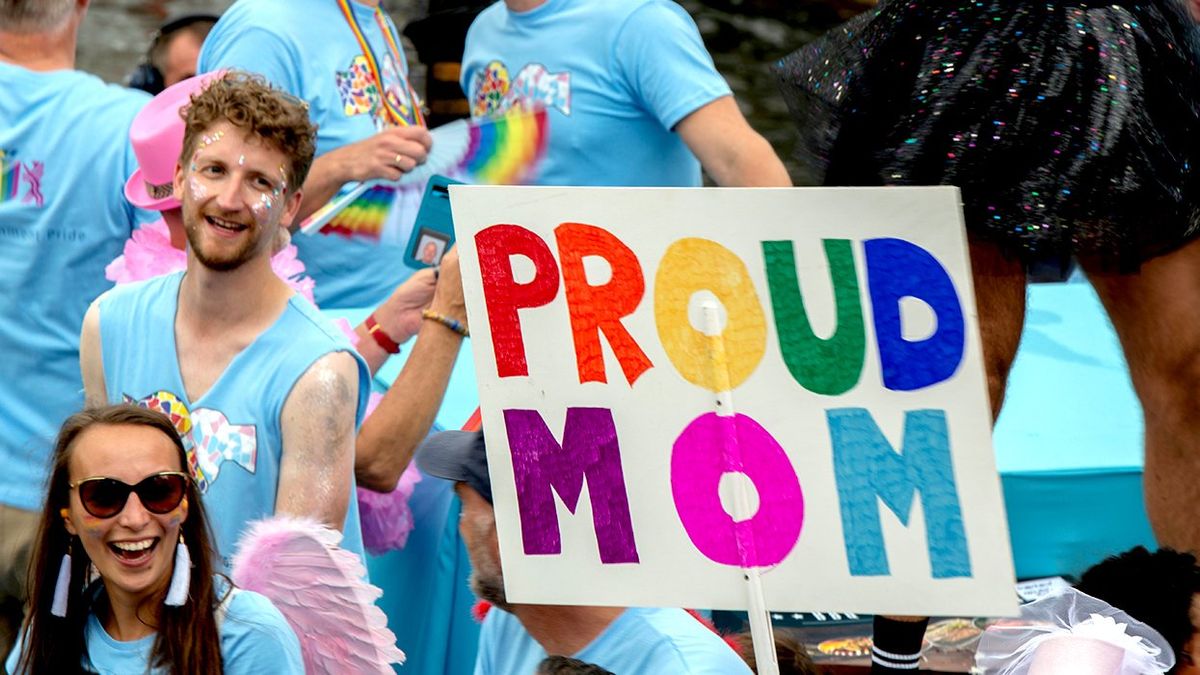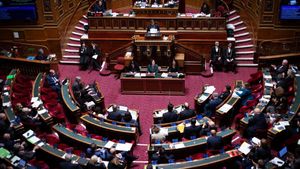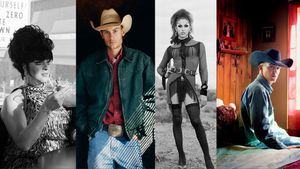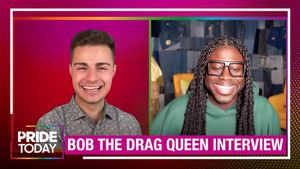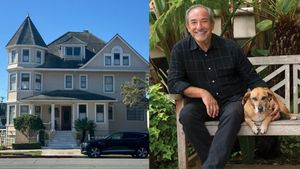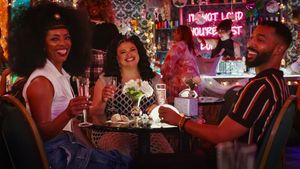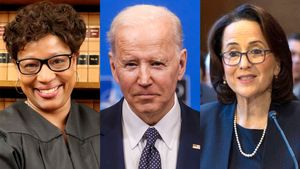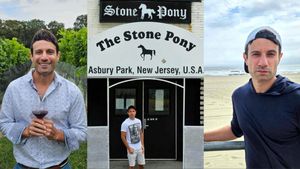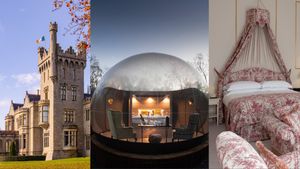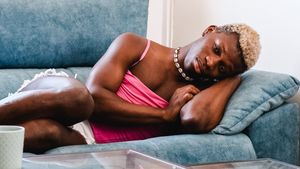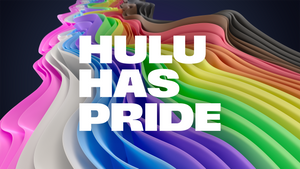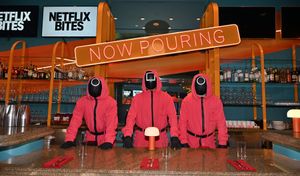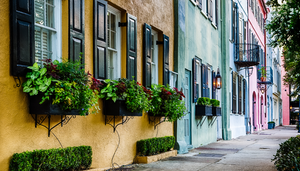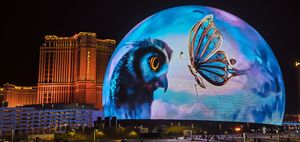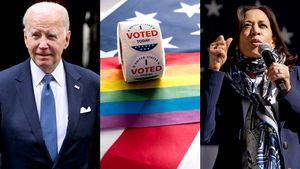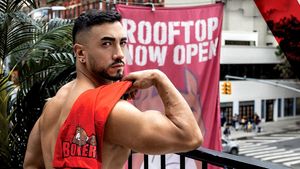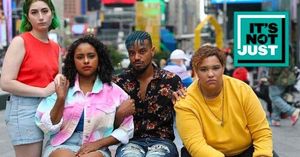Under a bank of neon lights, amid cryogenic smoke effects and confetti raining down from above, bodies move in exquisite unison to a driving rhythm. Bare torsos glisten, arms rise, and faces beam. It’s a scene that repeats from Miami to Montreal, from Fire Island to Palm Springs—a confluence of sound, sweat, and surrender.
 Stunning visuals and dancers add to the ambiance at CirctuitMOM’s Matador party during 2024 Market Days.Courtesy CircuitMOM Productions
Stunning visuals and dancers add to the ambiance at CirctuitMOM’s Matador party during 2024 Market Days.Courtesy CircuitMOM Productions
This is the circuit party, a global phenomenon of high-energy dance events deeply entwined with LGBTQ+ culture and history. Born in defiance and nurtured in adversity, these parties have evolved far beyond their modest origins as grassroots fundraisers. Today, the multi-day events around the world that form a loop, or the circuit, are cultural landmarks where celebration, resistance, activism, inhibition, and chosen family converge under a pounding beat.
Keep up with the latest in LGBTQ+ news and politics. Sign up for The Advocate's email newsletter.
These celebrations offer more than meets the eye. During the darkest days of the AIDS crisis, circuit parties provided a lifeline for queer men, a way to raise money, build solidarity, and insist on the right to exist in a hostile world. Now, they thrive as an expansive network of traveling tribes and glittering transformations. Although today’s circuit events dazzle with world-class production values, what lies beneath their bright exteriors is something deep and enduring: community. In these marathon gatherings, people from various backgrounds forge bonds that outlast the night.
Related: Winter Party Festival: 32 years celebrating that 'Dance Is Revolution'
The world of circuit parties unfolds as a cultural kaleidoscope: dazzling, defiant, and deeply human.
The dance floor as resistance
The circuit’s roots stretch back to the late 1970s and early 1980s, emerging from LGBTQ+ spaces in cities like New York and San Francisco. Early influences included the afternoon Tea Dances of New York’s Fire Island, which brought gay men together for afternoon social gatherings that evolved into high-energy dance events. Clubs like the Trocadero Transfer in San Francisco and The Saint in New York City became mythical venues known for their marathon disco parties, elaborate lighting, and a sense of liberation on the dance floor. These early gatherings laid the foundation for the circuit party culture, blending music, community, and celebration at a time when LGBTQ+ people faced significant social and legal barriers.
“Circuit parties came about at the moment in U.S. history when queer visibility was increasing, but so was a backlash,” Harvard professor of the practice in media and activism in studies of women, gender, and sexuality, Michael Bronski, author of A Queer History of the United States, tells The Advocate. “These gatherings were communal and defiant—a way to insist on our right to exist, love, and thrive.”
Even before the scale of AIDS became apparent, these events offered a beacon, he says. They were places to celebrate identity under hostile eyes. By the 1980s, circuit parties had expanded into large-scale themed events, with some of the most iconic emerging in cities like Miami, Palm Springs, and New Orleans. LGBTQ+ people claimed more public space as conservative forces fought to deny them. Then came HIV and AIDS, which unleashed an era of devastation. But amid grief, small benefit parties emerged—little fortresses of joy defying a world that demanded silence.
 Black & Blue in Montreal in the year 2000.Courtesy BLACK & BLUE MONTREAL
Black & Blue in Montreal in the year 2000.Courtesy BLACK & BLUE MONTREAL
“These events were a response to oppression, not just a celebration,” Bronski explains. “They became spaces for communal resistance and visibility, pushing back against efforts to erase queer existence.”
Over time, major weekends—such as the late Jeffrey Sanker’s White Party in Palm Springs and Miami’s Winter Party Festival—became defining moments of the movement and must-attend events. The White Party, launched in 1989, quickly became an extravagant spectacle of music, fashion, and revelry, drawing thousands to Palm Springs for a weekend of euphoric dance under the April desert sky. Winter Party Festival, founded in 1994, transformed Miami Beach into a pulsating celebration of LGBTQ+ unity, with its iconic beach party set against the backdrop of the Atlantic Ocean between February and March.
As these events gained prominence, thousands began traveling coast to coast, fueling the circuit’s expansion. New producers and DJs emerged, creating a sprawling network that defined an era and fostered reputations, friendships, and romances along the way.
 Lady Gaga performs at Jeffrey Sanker’s 20th annual White Party at the Palm Springs Convention Center on April 11, 2009 in Palm Springs, California.Noel Vasquez/FilmMagic
Lady Gaga performs at Jeffrey Sanker’s 20th annual White Party at the Palm Springs Convention Center on April 11, 2009 in Palm Springs, California.Noel Vasquez/FilmMagic
“You walk in, and everybody’s welcome, everybody’s smiling,” recalls Masterbeat founder Brett Henrichsen, who was “blown away” by his early experiences with the scene. His company, Masterbeat, became synonymous with high-energy, large-scale circuit productions, elevating the party experience with elaborate staging, cutting-edge sound, and top-tier talent.
The intoxicating allure of these events—and the larger circuit scene—was immortalized in Dirk Shafer’s 2001 film Circuit, a dark dive into the hedonistic world of nonstop parties, muscle-bound bodies, and chemical-fueled excess. The film painted circuit culture as both an escape and a trap.
Sanker, an icon in the circuit world, passed away in 2021 after battling liver cancer, but his legacy endures in the electrifying energy of every packed dance floor.
Related: White Party Founder Jeffrey Sanker Has Died
Susan Morabito, a legendary DJ whose four-decade career has tracked the arc of LGBTQ+ history, recalls the urgency of those early years. Now professionally known by her last name alone, Morabito describes how the circuit scene provided refuge.
 Legendary musical queen of the ciruit, DJ Morabito.Chad Herndon for Morabito
Legendary musical queen of the ciruit, DJ Morabito.Chad Herndon for Morabito
“The circuit started because of the AIDS epidemic,” she tells The Advocate. “It gave people a place to grieve, to find joy, and to hold each other up.”
Music is the pulse of the circuit
Central to the circuit scene is its music, and DJs like Morabito are its master orchestrators. Known for her storytelling approach, Morabito sees herself as a “journey DJ,” crafting arcs that build to climaxes and then descend into gentle landings. “Back then, we’d play entire nights—eight to ten hours. Now, you often see two or three DJs sharing the event,” she reflects.
Bronski says the role of music in circuit culture is part of a broader trend in American history. “From jazz to disco, queer culture has always been at the forefront of reshaping music,” he says. “The circuit elevated that tradition, using music as a medium for storytelling and connection.”
Though some associate a specific sound with circuit parties, Morabito insists that “circuit music” isn’t a genre. Instead, the sound has evolved, moving from disco to house to the synth-driven big-room style of the early 2000s. “I’ve moved away from the big-room sound and now lean toward house, tech house, and melodic techno,” she says, attributing this evolution partly to generational shifts.
 Dancers in elaborate costumes dance at the Purple Party in Dallas.
Dancers in elaborate costumes dance at the Purple Party in Dallas.
Dan Slater, currently one of the scene’s most sought-after DJs, reflects on how music has shaped the circuit over the years. He agrees with Morabito. "People often ask what circuit music is, but it’s not a genre," Slater tells The Advocate from his hotel room ahead of a gay cruise he’s embarking on to spin music for a circuit party at sea the next day. “It’s about the environment you create—a mix of house, techno, and even disco. The music changes year by year and reflects shifts in culture and taste.”
DJs like Slater now juggle more than just music. "Being a DJ isn’t just about playing tracks," he says. "You’re a performer, a producer, and even a social media marketer. There’s so much that goes on behind the scenes to make each event feel special."
DJ Chris Cox of the iconic Grammy-nominated production duo Thunderpuss believes music is the heart of the circuit.
 Thousands celebrate queerness, togetherness and music at a Winter Party event.Adi Adinayev for Winter Party Festival
Thousands celebrate queerness, togetherness and music at a Winter Party event.Adi Adinayev for Winter Party Festival
“When we remixed tracks like Whitney Houston’s “It’s Not Right, But It’s Okay,” we weren’t just creating hits; we were channeling community resilience,” he says.
For Cox, crafting these moments involved technical precision and creative flair. “I started thinking about how to make the music bigger, how to make it hit harder in these massive spaces,” he tells The Advocate. “It wasn’t just about the tracks themselves but about creating an entire journey. You’d have these driving, intense moments that build up, release into joyous singalongs, and then pull back into something darker and more introspective.”
To Grammy-nominated producer and DJ Tony Moran, the circuit was not just a career path but a transformative rite of passage. “When I first started producing music, it was all about creating hits for the mainstream,” Moran says, reflecting on his beginnings in the Latin pop world as part of the group Latin Rascals. “But when I stepped into the circuit, it became about something more—connection, community, and telling our stories through music.”
 Elaborate staging is key to the environment at a CircuitMOM Matador party.Courtesy CircuitMOM Productions
Elaborate staging is key to the environment at a CircuitMOM Matador party.Courtesy CircuitMOM Productions
Moran’s journey began in New York City, navigating an evolving scene that was as much about personal liberation as musical experimentation. “At first, I didn’t even go to places like The Saint. I was too busy with my career,” he recalls. “But once I came out, I realized that this wasn’t just about dancing—it was about finding myself and being part of something bigger.”
The Saint wasn’t just a nightclub—it was a revolution in sound, space, and community. Opened in 1980 in New York City’s East Village, the exclusive members-only club that closed in 1988 quickly became the epicenter of gay nightlife, transforming the former Fillmore East theater into an otherworldly dance sanctuary. More than a place to party, The Saint embodied a newfound sense of queer liberation, where thousands of men danced through the night, embraced by music, freedom, and each other.
Moran says that a circuit party’s music is an emotional journey. “It’s about taking people on a ride, from euphoric highs to introspective lows,” he explains. “You create a space where everyone feels they belong, even if it’s just for one night.”
A transformative rite of passage
For many, their first circuit party is nothing short of revelatory.
“It’s like a religious revival,” Bronski explains. “At their best, circuit parties are sacred spaces where attendees connect with themselves and with others in deeply meaningful ways.” He likens the experience to medieval festivals, which offered people a break from the rigid hierarchies of everyday life and a vision of what society could be. “Circuit parties, much like those festivals, are both escapist and aspirational,” he explains.
People of all ages find themselves at circuit events. Some discover and join the scene in their early 20s and dip back out as they venture through life. Others stay for decades and find the allure of the dancefloor as never-ending.
Andrew MacLeod Baldwin recalls walking into the Black Party inNew York City in the 1990s and feeling an immediate sense of belonging. “I realized I’d found my tribe,” Baldwin says. Longtime circuit producer in Miami Hilton Wolman describes the experience as “shedding your everyday life to truly be yourself.” In the 1990s, Wolman discovered the circuit and found the meaning of true love when he came out to his wife in Atlanta asbisexual. The two remain married and share adult children decades later.
 Longtime event producer Hilton Wolman (right) and DJ Danny Verde at one of Wolman’s Urge Miami events.Marques Daniels via Hilton Wolman
Longtime event producer Hilton Wolman (right) and DJ Danny Verde at one of Wolman’s Urge Miami events.Marques Daniels via Hilton Wolman
“I needed to come out and tell my wife what was going on, and at that time, I thought we were headed for divorce,” Wolman tells The Advocate. “But in fact, we did some counseling and figured, you know, we love each other.” He says that after some counseling, his wife accepted his bisexuality. “Me being out and open about bisexuality and being able to express that was tough for my wife, but she agreed, and she started coming to the parties with me, and I think the first one we went to together was Black & Blue in Montreal in 1998.”
Montreal’s Black & Blue Festival, founded in 1991, became one of the most celebrated and ambitious gatherings in the circuit world. Organized by the Bad Boy Club Montréal Foundation, Black & Blue distinguished itself not just through its massive all-night parties but also its deep-rooted commitment to philanthropy, with proceeds supporting HIV and AIDS organizations and LGBTQ+ causes.
Held every October over Canadian Thanksgiving weekend, Black & Blue transformed Montreal into a pulsating playground of sound, light, and spectacle, with its main event often set in grand venues like the Olympic Stadium or Palais des congrès.
“It was like playing the Super Bowl of circuit parties,” Cox, who has spun the event, says. “You’d walk out into the snow at 10 a.m. after playing for hours, and it was magic. Everyone was there for the music, the community, and the experience.”
 The legendary Black & Blue parties in Montreal in 1998 and 2004.Courtesy BLACK & BLUE MONTREAL
The legendary Black & Blue parties in Montreal in 1998 and 2004.Courtesy BLACK & BLUE MONTREAL
Joe Fischel, an associate professor of Women’s, Gender, and Sexuality Studies at Yale University and author of Screw Consent, admits he’s not a historian of circuit culture. He views circuit parties as moments of joy and hedonic escapism. “Life is full of tragedy and misery and inequality,” he says. “Joy and pleasure are integral to a fulfilling life. Gay subculture, including the circuit, reminds us that having joy isn’t just acceptable—it’s vital.”
Fischel compares circuit gatherings to his own experiences at Provincetown or gay cruises, where camaraderie and shared moments define the experience. “It’s not just about escaping the world—it’s about creating fleeting yet meaningful connections,” he says.
Morabito, who has spent over four decades behind the decks, has witnessed countless personal evolutions on the dance floor.
“There’s one guy I see at Fire Island, always dancing alone but having the most magnificent time,” she recounts. “People like him are fixtures—unique individuals who embody the spirit of the circuit.” That spirit, expressed through carefree dancing and joy, is the circuit at its best, she says.
As one of the few women DJs in the scene, Morabito says that the relationships she’s built in the scene are profound. “Some of my friendships go back 35 years. We’ve laughed, cried, and grown together,” she says. For her, these connections, forged under the pulsating lights of the dance floor, are deeply meaningful.
For Slater, who is from Australia but now lives in Dallas (home of the Purple Party), performing at Winter Party in Miami, which turned 32 this year, holds a special place in his heart. "[Last] year, one of my exes and his current boyfriend came to see me play," he shares. "It’s wild to think about how far we’ve all come—and to share that moment halfway across the world was incredible.”
 The Winter Party Beach Party is one of the most spectacular circuit party events in the world.Lauren Morell for Winter Party Festival
The Winter Party Beach Party is one of the most spectacular circuit party events in the world.Lauren Morell for Winter Party Festival
Winter Party Festival, which took place over the weekend and ended Monday, draws massive crowds to Miami Beach each March for a week of high-energy dance events, top-tier DJs, and iconic beachfront revelry. At its heart is the beach party, where thousands dance under the sun with the Atlantic as their backdrop. With its unmatched production, world-class talent, and community-driven purpose, it remains a defining experience in the global circuit scene.
For Slater, family, both biological and chosen, plays a key role in the satisfaction he gets from performing at circuit parties. “My mom came to see me DJ at WorldPride [in Sydney]," Slater recalls. "Seeing her experience everything I’d worked so hard to create was unforgettable."
Creating a vibe
For Russell Roybal, circuit parties are more than just music and lights—they are transformative spaces of joy, affirmation, and belonging. As the producer behind Winter Party’s beach party, Roybal has helped shape one of the LGBTQ+ community’s most celebrated events, blending celebration with activism. The weekend is coordinated by The National LGBTQ Task Force and benefits political advocacy work. Having been involved with Winter Party for over a decade, Roybal’s connection to the scene is deep.
His journey began in the early 1990s when he attended the Zoo Party in San Diego. “It was magical,” he recalls, remembering how the event offered LGBTQ+ people a temporary escape from the burdens placed on them by society.
The Zoo Party was a defining event in San Diego’s LGBTQ+ nightlife, blending the high-energy atmosphere of a circuit party with the whimsical setting of the world-famous San Diego Zoo. From 1996 until 2022, as part of San Diego Pride weekend, it stood out from traditional club-based circuit events by offering an open-air experience where attendees danced under the stars, surrounded by lush landscapes and exotic animals. Proceeds from the event supported the San Diego LGBT Community Center.
That experience solidified his passion for the circuit scene, leading him to Winter Party, which he later helped produce.
Winter Party’s unique blend of celebration and purpose is central to its identity. “We push messages like voting or filling out your census form,” Roybal explains. The event’s “Live Free, Play Hard, Give Back” tagline captures that spirit of joy and activism.
 CircuitMOM events include creative themes like the 2019 Dick Tracy performance.Courtesy CircuitMOM Productions
CircuitMOM events include creative themes like the 2019 Dick Tracy performance.Courtesy CircuitMOM Productions
Matthew Harvat and Edwin Martinez, the dynamic duo behind Chicago’s CircuitMOM Productions, have shaped the circuit party scene for over two decades. Harvat, affectionately known as “Circuit Mom,” began his journey in 1996 when he first earned the moniker by providing water to partygoers during the Hotlanta circuit party weekend. “I was just trying to help out, and someone called me ‘Circuit Mom,’ and it stuck,” he recalls.
Hotlanta River Expo, launched in 1978, was a Labor Day weekend event that transformed Atlanta into one of the first circuit party hotspots, blending high-energy dance parties with daytime adventures like tubing down the Chattahoochee River. Known for its Southern hospitality, the festival attracted thousands of revelers, making it a must-attend on the circuit calendar. Though it faded in the early 2000s, its legacy lives on in the memories of those who danced, floated, and celebrated in one of the South’s most iconic LGBTQ+ events.
Harvat’s background in theater and production set the stage for his unique approach to event planning, where creativity and community are at the forefront. “Dance parties have always been about connection,” Harvat emphasizes. Martinez joined Harvat twelve years ago, bringing a fresh perspective and relentless energy to the team. “I hated my life in health care, but with Circuit Mom Productions, I found work that excites me,” Martinez says.
Together, they have built a reputation for creating inclusive, innovative events that blend elaborate storytelling, intricate costuming, and immersive experiences with world-class DJ talent. “We sell Broadway meets rave,” Martinez explains.
CircuitMom Productions has become synonymous with creativity, care, and community through its leadership, particularly for its largest events during Chicago’s annual two-day Northalsted Market Days in August. Harvat says, “I don’t want us to lose that connection.”
Chosen families and the traveling tribe
If the circuit has a soul, it is in its ability to forge connections that transcend the dance floor.
Circuit culture thrives on mobility. Attendees often spend hundreds or thousands of dollars on travel, hotels, and event passes. People follow promoters, annual weekends, or certain DJs, building networks that cross continents. Events dot calendars worldwide. Loyalty forms. “Circuit queens” find themselves reuniting again and again, bonding under laser beams and cascading confetti.
Wolman describes the camaraderie as a “traveling tribe” where familiar faces reappear at events across the globe.
For many, the circuit is more than a string of parties—it’s a chosen family that forms through shared experiences and profound relationships on the dance floor. Brent Solomon, who began sneaking off to Washington, D.C., and Baltimore for circuit parties as a teenager, reflects on how the circuit helped him find his place in the world. “Back then, it was such a tight community. Everyone went in groups—three cars heading up to a party together. It felt like family,” he recalls. “Even now, there are people I haven’t seen in years, but if I ran into them, it would feel like no time had passed.”
 Some circuit parties have tea dances and pool parties that offer partygoers more than nighttime club events.
Some circuit parties have tea dances and pool parties that offer partygoers more than nighttime club events.
The familial aspect of the circuit was especially meaningful to those coming from unwelcoming environments. Solomon, who grew up in conservative Richmond, Va., which is now much more progressive, described the circuit as a sanctuary. “Richmond wasn’t a safe space back then. But in the circuit, I could wear what I wanted, act how I wanted—I could just be free,” he says.
For Solomon and others, the circuit also provided a stage to grow and evolve. He recounts how his early fascination with DJs and promoters eventually led him to a career in event production, where he could recreate the magic he once admired. “I wanted to take everything I loved about the scene and make it even better and more inviting,” he says. “There was nothing like standing on the dance floor at 2 a.m., looking out at the crowd, and seeing everyone so happy. It was a kind of joy you can’t explain—it was a family.”
For Gregory Johnson and Brandon Cyphers, the circuit party scene was a transformative space—one where chosen families formed and self-expression flourished, but also a place where being Black in a predominantly white culture came with challenges.
Cyphers got introduced to the circuit in 1999 by his resident advisor at James Madison University in Harrisonburg, Va. “Chris gave me a crash course in being gay,” Cyphers recalls. “He took me to Velvet Nation [in D.C.] and shared stories about New York clubs and DJs like Junior Vasquez.” With his guidance, Cyphers says he navigated his early experiences, building confidence in a world that initially felt overwhelming.
Similarly, Johnson discovered the circuit at Washington, D.C.’s Velvet Nation at 18, describing it as a “fantasy land” where he could escape societal pressures.
“You’d walk in, and it was this incredible escape. People were shirtless, immersed in the music, and completely in the moment,” he says. “It was a place where models, celebrities, and everyday folks blended together in a way that felt effortless.”
At the turn of the millennium, Velvet Nation wasn’t just a party—it was a pilgrimage. From 1999 to 2006, every Saturday night, the cavernous Nation nightclub in the nation’s capital pulsed with the hypnotic throb of house and tribal beats, its vast, industrial-chic expanse illuminated by sweeping laser lights and the feverish energy of partygoers.
Here, Cherry, D.C.’s ongoing annual circuit party, launched by the all-volunteer Cherry Fund in 1996, at a time when dance floors were not just spaces of escape but of resilience. On the circuit calendar, Cherry is a must-attend April spectacle, drawing thousands from across the country for a weekend of unapologetic queer celebration. Held in some of the city’s most dynamic venues, from underground clubs to the historic Old Post Office Pavilion, the event evolved with the times but never lost its essence: a euphoric collision of music, community, and purpose.
 Flyers advertising major circuit parties.Courtesy BLACK & BLUE MONTREAL; Courtesy CircuitMOM Productions
Flyers advertising major circuit parties.Courtesy BLACK & BLUE MONTREAL; Courtesy CircuitMOM Productions
Johnson says that, of course, there are challenges. Although all were welcome at these events, he says the lack of diversity at some circuit parties around the country was stark. “You could tell who the party was for by looking at the flyer,” Johnson says. Over time, he says, events have worked to center people of color, but representation still varies by location and promoter.
Despite its flaws, the circuit offered both men opportunities for connection. “The guy I’m dating now? We met at a circuit party,” Johnson says.
That sense of connection was both liberating and grounding for Johnson, who, like many, found the circuit to be a place where traditional hierarchies dissolved. “You’d see a doctor, an entrepreneur, and someone who worked retail all dancing together,” he says. “Everyone takes off their shirts, puts on a harness or a jockstrap, and suddenly we’re all the same.”
However, he says, that doesn’t mean the circuit can’t also be exclusionary. “You see the tip of everyone’s iceberg—their best selves, after weeks of training, dieting, and buying costumes for the party,” he says. The circuit crowd is often criticized for a focus on vanity, which Johnson says is a legitimate critique. “But every now and then, someone surprises you with how cool they are, and that relationship carries on,” he says.
For Johnson, the relationships forged through circuit culture have been transformative. While he once approached the scene with a sense of awe—“worshiping” the shirtless “circuit boys” he admired—he now moves through it with confidence. “I went from begging to get into VIP to having my pass handed to me before I arrived,” he laughs. “It’s been a journey.”
Sex and drugs in the circuit
Circuit events have always hummed with desire. Sex and drugs, though controversial, are part of the tapestry. Bronski compares them to ancient bacchanals of Rome and Greece—ecstatic, uninhibited celebrations of pleasure, where music, movement, and indulgence coalesced into a communal ritual of escape.
Fischel notes that in these spaces, consent and norms can feel different—there’s a code of conduct shaped by context. Having written extensively about norms and consent, he explains that behavior at circuit parties often falls into unique social contexts.
“Consent operates differently in these spaces,” he says. “There’s an understanding that some contact is part of the environment, but people generally know when they’re crossing a line.” He notes that the choice of drugs also influences the tone of these events, with substances like the so-called “date rape drug” GHB, MDMA or ecstasy, and methamphetamine shaping both the dance floor and the after-parties. “Different drugs create different vibes,” Fischel adds. “Some enhance the music and movement; others shape what happens in the darker corners.”
 Throngs of dancing attendees party at Black & Blue in Montreal, 2019.Courtesy BLACK & BLUE MONTREAL
Throngs of dancing attendees party at Black & Blue in Montreal, 2019.Courtesy BLACK & BLUE MONTREAL
With the increased use of PrEP (pre-exposure prophylaxis) and doxyPEP (doxycycline post-exposure prophylaxis), Fischel says, participants in these spaces have access to tools that help manage HIV risk and prevent sexually transmitted infections. “Queer culture has always been about adapting to changing circumstances, and these new medications provide people with a greater sense of security in spaces where pleasure and risk coexist,” Bronski adds.
Fischel also observes the influence of respectability politics on how circuit culture is perceived. Both scholars recognize the complexity of these dynamics, where liberation and risk coexist in ways unique to queer spaces. Fischel warns against the tendency to scapegoat circuit culture within the LGBTQ+ community.
“Circuit parties often bear the brunt of respectability politics within the LGBTQ+ community,” he says. “They’re seen as frivolous or deviant by some, but that critique often overlooks their deeper significance as spaces of freedom and joy.”
Liberation meets complexity
While circuit culture celebrates freedom, it has also faced criticism for its exclusivity–racial or economic, given that traveling around the world for parties is something not everyone can afford. Bronski highlights the challenges of navigating this complexity, acknowledging that efforts to create more inclusive spaces are a work in progress. “Circuit parties reflect both the aspirations and the limitations of queer culture,” he says. “They are mirrors of the society they exist within—capable of great joy but also marked by the same biases and exclusions.”
 Many circuit parties have made significant efforts toward bringing in diverse crowds through their advertising.
Many circuit parties have made significant efforts toward bringing in diverse crowds through their advertising.
Historically dominated by well-to-do white, cisgender gay men, the scene is now reckoning with its shortcomings. Many involved in the scene make deliberate moves to include diverse models and dancers and draw people from all walks of life into the festivities. “In Miami, we’ve made sure our events reflect the diversity of our community,” Wolman says. He says that great effort is taken to hire dancers and models from diverse backgrounds so that everybody can see themselves represented.
Morabito celebrates the changes she sees on the dance floor. “It’s not just muscular, white men anymore. There are more women, more people of color, more gender-diverse folks. That’s what makes the circuit vibrant.”
Necessary pleasures
“For a few nights, the world turns upside down, and you see possibilities beyond the ordinary,” Bronski says. He stresses the enduring relevance of circuit parties as spaces of transformation and transcendence. “At their best, they are not just celebrations—they are acts of resistance and visions of liberation.”
 In 2022, CircuitMOM added a mechanical bull to the center of a circuit event.Courtesy CircuitMOM Productions
In 2022, CircuitMOM added a mechanical bull to the center of a circuit event.Courtesy CircuitMOM Productions
At a time when the LGBTQ+ community once again faces political and legal threats, circuit parties continue to serve as vital sanctuaries, offering not just an escape but a reimagining of what community, freedom, and joy can look like. To dance in these spaces, surrounded by people with a common history of struggle and resilience, is to participate in something far greater than a party. It is an affirmation of presence and the right to exist without shame or fear.
Fischel agrees. “They’re vital reminders that connection and pleasure are not indulgences—they’re necessities,” he says.
Wolman adds, “The circuit isn’t just a scene—it’s a family. And for those who’ve found their place on the dance floor, it’s a home.”
If you're interested in checking out a circuit party, the website Circuit Party Info has you covered as a one-stop-shop resource for the goings on within the circuit.


 Stunning visuals and dancers add to the ambiance at CirctuitMOM’s Matador party during 2024 Market Days.Courtesy CircuitMOM Productions
Stunning visuals and dancers add to the ambiance at CirctuitMOM’s Matador party during 2024 Market Days.Courtesy CircuitMOM Productions Black & Blue in Montreal in the year 2000.Courtesy BLACK & BLUE MONTREAL
Black & Blue in Montreal in the year 2000.Courtesy BLACK & BLUE MONTREAL Lady Gaga performs at Jeffrey Sanker’s 20th annual White Party at the Palm Springs Convention Center on April 11, 2009 in Palm Springs, California.Noel Vasquez/FilmMagic
Lady Gaga performs at Jeffrey Sanker’s 20th annual White Party at the Palm Springs Convention Center on April 11, 2009 in Palm Springs, California.Noel Vasquez/FilmMagic Legendary musical queen of the ciruit, DJ Morabito.Chad Herndon for Morabito
Legendary musical queen of the ciruit, DJ Morabito.Chad Herndon for Morabito Dancers in elaborate costumes dance at the Purple Party in Dallas.
Dancers in elaborate costumes dance at the Purple Party in Dallas. Thousands celebrate queerness, togetherness and music at a Winter Party event.Adi Adinayev for Winter Party Festival
Thousands celebrate queerness, togetherness and music at a Winter Party event.Adi Adinayev for Winter Party Festival Elaborate staging is key to the environment at a CircuitMOM Matador party.Courtesy CircuitMOM Productions
Elaborate staging is key to the environment at a CircuitMOM Matador party.Courtesy CircuitMOM Productions Longtime event producer Hilton Wolman (right) and DJ Danny Verde at one of Wolman’s Urge Miami events.Marques Daniels via Hilton Wolman
Longtime event producer Hilton Wolman (right) and DJ Danny Verde at one of Wolman’s Urge Miami events.Marques Daniels via Hilton Wolman The legendary Black & Blue parties in Montreal in 1998 and 2004.Courtesy BLACK & BLUE MONTREAL
The legendary Black & Blue parties in Montreal in 1998 and 2004.Courtesy BLACK & BLUE MONTREAL The Winter Party Beach Party is one of the most spectacular circuit party events in the world.Lauren Morell for Winter Party Festival
The Winter Party Beach Party is one of the most spectacular circuit party events in the world.Lauren Morell for Winter Party Festival CircuitMOM events include creative themes like the 2019 Dick Tracy performance.Courtesy CircuitMOM Productions
CircuitMOM events include creative themes like the 2019 Dick Tracy performance.Courtesy CircuitMOM Productions Some circuit parties have tea dances and pool parties that offer partygoers more than nighttime club events.
Some circuit parties have tea dances and pool parties that offer partygoers more than nighttime club events. Flyers advertising major circuit parties.Courtesy BLACK & BLUE MONTREAL; Courtesy CircuitMOM Productions
Flyers advertising major circuit parties.Courtesy BLACK & BLUE MONTREAL; Courtesy CircuitMOM Productions Throngs of dancing attendees party at Black & Blue in Montreal, 2019.Courtesy BLACK & BLUE MONTREAL
Throngs of dancing attendees party at Black & Blue in Montreal, 2019.Courtesy BLACK & BLUE MONTREAL Many circuit parties have made significant efforts toward bringing in diverse crowds through their advertising.
Many circuit parties have made significant efforts toward bringing in diverse crowds through their advertising. In 2022, CircuitMOM added a mechanical bull to the center of a circuit event.Courtesy CircuitMOM Productions
In 2022, CircuitMOM added a mechanical bull to the center of a circuit event.Courtesy CircuitMOM Productions



















